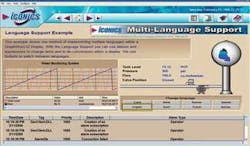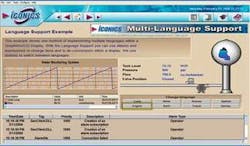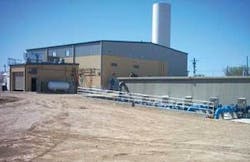System Meets Treatment Plant’s Multilingual Operational Needs
The Webb County Water Treatment Plant (WTP) in Rio Bravo, TX, is situated near the Rio Grande River, south of San Antonio. In order to meet population growth and to respond to rising water quality requirements, the county constructed a new water treatment plant that included a modern SCADA system.
Spanish is the native language for most of the plant personnel and several of them were not fluent in technical English. To allow staff to use the new SCADA system in their own language, the district wanted a system that offered the ability to switch between English and Spanish. The CH2M Hill SCADA project team and Webb County engineers selected the Iconics Genesis32 suite of OPC Web-enabled HMI and SCADA applications. During the design development time, it was the only major HMI package that included language switch ability.
Webb County and CH2M Hill also selected Iconics AlarmWorx32TM MMX alarm notification software and WebHMITM for secure remote access.
To meet the requirements for water quality, desired water production, and efficient plant operation and maintenance, the new plant needed sophisticated instrumentation and control systems. However, the operations and maintenance staff was largely unfamiliar with computerized control systems, so the developed SCADA system had to be based on a user-friendly, graphically enhanced package.
The multi-language switching capability was implemented on all HMI graphic screens. Iconics Genesis32 Language Configurator provides this functionality using a technique described as language aliasing. Language aliasing employs an embedded dictionary along with the use of special delimiters incorporated with the HMI screens to substitute a character string (the English or Spanish phrase) for the alias phrase.
A phrase is identified as a language alias by surrounding it with the special characters “/+” and “+/”. When a phrase surrounded by these characters is encountered on a HMI screen, the system looks up the phrase in the developed, pre-defined language dictionary. It then replaces the alias phrase with the entry from the dictionary that matches the currently selected language. This aliasing works on either static characters on an HMI screen or on an alarm message that appears on an alarm summary screen.
Operators can change the language in the runtime environment without the need to enter a programming environment.
At the bottom right hand corner of every screen are buttons labeled “English” and “Español.” By selecting the button labeled Español, all the language aliases are replaced with their Spanish translations. In addition, a default language is assigned for each user defined for the HMI system, to be displayed each time that operator logs in. The default language selection, combined with the ease of switching languages, makes it very simple for operators to use the system in whichever language they feel most comfortable.
The implementation of the language aliasing features on the Webb County Water Treatment Plant SCADA system, while straightforward, was not trivial. The words and phrases being translated were not normal conversational Spanish, so a fair amount of research was required to find suitable translations for the technical terms. If English phrases were translated one word at a time, the resulting phrase in Spanish would not make sense. This made it necessary to break down translation text into phrases that could stand alone, increasing the number of unique phrases in the dictionary, as well as the complexity of defining and implementing the phrases. In addition, the graphics were originally developed in English before the dictionary was defined.
Once translations were in place, it was discovered that the Spanish phrases were often considerably longer than the English version. In many cases, these longer phrases would cover up other objects on the screen or would obscure other text. For these cases, the Spanish translation text was defined in the dictionary to include multiple lines of text. Similarly, there were some instances where the same phrase needed to be displayed in title case (the first letter of each word capitalized) in some locations and in all capitals in other locations. To allow the phrases to be displayed in differing case, the dictionary had two entries for each of these phrases and the alias was modified to indicate the appropriate case.
By considering these details, the screens appear normal in both English and Spanish. Neither version appears to be a “translated version.” No matter which language is being viewed, it looks like the screen was developed using that language.
The Iconics-enabled multi-language support is a convenience to most of the operators, maintenance personnel, and Webb County engineering and management staff that are fluent in both languages. It’s a necessity for safe water plant operation for those who might not be confident in using one specific language.
Iconics Genesis32 remote alarm notification, real time and historical trending, automated reporting, and secure remote access and monitoring via thin client technology were implemented to allow for ease of monitoring and operation. Webb County worked closely with their engineering partner, CH2M Hill in the Austin office, to ensure the smooth transition in plant operations. The development of, and adherence to, the HMI software design standards resulted in simple and clear control screens.
By employing functionality such as reporting systems, remote access to control system data, remote alarm notification, language aliasing, and having the software fully developed and thoroughly tested at the CH2M Hill SCADA lab, Webb County WTP users were able to adapt to the computerized control system quickly.



